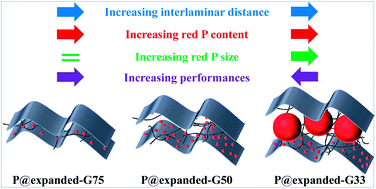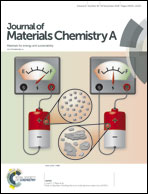Ultrafine red P nanoconfined between expanded graphene sheets for high-performance lithium-ion batteries†
Abstract
A novel and facile strategy is proposed to synthesize red P nanoconfined between expanded graphene sheets (P@expanded-G) as an anode material for lithium-ion batteries by oxidation-assembly-reduction, followed by a high-temperature infiltration method. It is found that an appropriate interlaminar distance of graphene sheets, which is achieved by tailoring the mass ratio of graphene and carbon nanotubes, can ensure high loading content and effective nanoconfinement of red P simultaneously, resulting in high electrochemical performances for the P@expanded-G samples. For instance, the optimized P@expanded-G50 anode exhibits a specific capacity as high as 1010 mA h g−1 based on the total mass (2053 mA h g−1 based on the red P mass) with a coulombic efficiency close to 100% after 500 cycles at 0.1 A g−1. Moreover, as the current density increases to 2.0 A g−1, the specific capacity still remains over 440 mA h g−1 (based on the total mass) with progressive cycling up to more than 2000 cycles. Structural characterization reveals that the existence of a large amount of uniformly nanoconfined red P between the expanded graphene sheets and the formation of P–C and P–O bonds are mainly responsible for the much improved electrochemical performances.



 Please wait while we load your content...
Please wait while we load your content...